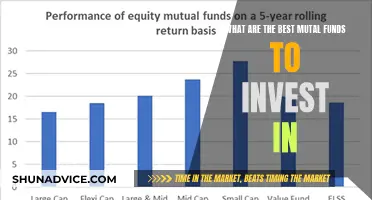
Investing in mutual funds is a great way to build wealth over time and achieve financial goals, such as buying a house or retiring comfortably. Mutual funds are a type of investment vehicle that pools money from multiple investors to invest in securities such as stocks, bonds, and short-term debt. By investing in mutual funds, individuals gain instant diversification across various companies and industries, reducing the risk associated with investing in individual stocks.
When investing in mutual funds, there are two main strategies to consider: active and passive investing. Active funds aim to beat the market by employing professional fund managers who actively select stocks and bonds, while passive funds aim to mimic the performance of a market index, such as the S&P 500. Active funds tend to have higher fees due to the cost of research and professional management, while passive funds offer lower fees and have consistently outperformed active funds over the long term.
Before investing in mutual funds, it is crucial to set clear financial goals, understand your risk tolerance, and conduct thorough research on the different types of mutual funds available. Additionally, it is important to consider the fees associated with mutual funds, such as expense ratios and sales loads, as these can eat into your investment returns over time.
By following these steps and staying committed to your investment strategy, you can effectively utilize mutual funds to build a diversified portfolio and work towards achieving your financial objectives.
| Characteristics | Values |
|---|---|
| What is a mutual fund? | A mutual fund is a pool of money collected from investors that is then invested in securities such as stocks, bonds, or short-term debt. |
| Who should invest in a mutual fund? | Mutual funds can be a good option for both beginners and experienced investors. They offer diversification and allow experienced investors to target specific areas. |
| Active vs. passive funds | Active funds are managed by professionals aiming to beat the market, while passive funds aim to match the market's performance. Passive funds tend to have lower fees. |
| Types of mutual funds | There are various types, including stock funds, bond funds, money market funds, and target-date funds. |
| How do mutual funds make money? | Mutual funds make money by investing in securities on behalf of investors. Income can come from interest or dividend payments, while appreciation can be reflected in the net asset value per share or distributed as capital gains. |
| How to choose a mutual fund | Consider the fund's investment objectives, overall approach, and fees. Understand the drivers of its long-term performance and whether it aligns with your financial goals and risk tolerance. |
| How to buy and sell mutual funds | Mutual funds can be bought through online brokers or the fund manager. They are priced at the end of each trading day based on their net asset value (NAV). They can be sold similarly, and you will receive the next available NAV as your price. |
| Mutual fund fees | Mutual funds may have management fees, 12b-1 fees, and other expenses such as legal and accounting costs. Some funds also have sales commissions ("loads") charged during purchase or sale. |
| How to manage a mutual fund portfolio | Consider rebalancing your portfolio annually to maintain your desired asset allocation. Don't chase short-term performance; focus on long-term returns and consistency. |
| Average mutual fund returns | Stock mutual funds offer higher potential returns but also higher risk. Bond mutual funds provide more stable returns, while money market funds offer the lowest returns and lowest risk. |
| Risks of mutual funds | It is possible to lose money in mutual funds. Diversification helps spread risk, but time is a crucial factor. Short-term investments may not allow enough time to ride out market peaks and valleys. |
What You'll Learn

Understand the basics of mutual funds
Understanding the basics of mutual funds is essential before investing. Here's a detailed guide to help you get started:
Mutual funds are investment vehicles or portfolios that pool money from multiple investors. These funds are managed by professionals who invest in securities such as stocks, bonds, and short-term debt. Each investor buys shares in the mutual fund, representing their part ownership and the income generated. Mutual funds are known for offering professional management and instant diversification by investing in a range of companies and industries.
Mutual fund managers collect money from many investors and invest it in various securities. The combined holdings of the fund form its portfolio. Each share in the fund represents an investor's proportional interest, so the more shares owned, the larger their interest. For example, if a fund holds 5% of its portfolio in Apple and 2% in Tesla, an investor's share will reflect the same proportions.
Benefits of Mutual Funds
Mutual funds provide investors with quick exposure to a diversified portfolio of assets. They offer instant diversification, which reduces investment risk. Additionally, by pooling resources, investors can access professional investment management services at a reasonable cost. Mutual funds are also relatively cheap and simple to invest in, thanks to the availability of trading apps and online brokerages.
Types of Mutual Funds
There are two main types of mutual funds: actively managed funds and passively managed funds. Actively managed funds aim to beat the market by employing investment managers who actively pick stocks and bonds expected to outperform. These funds charge higher fees due to the research and management involved. On the other hand, passively managed funds, also known as index funds, aim to match market benchmarks like the S&P 500. They have lower fees since they don't actively try to beat the market.
Understanding Mutual Fund Fees
Mutual funds have various fees that impact investment returns. These include expense ratios, which are annual fees expressed as a percentage of the invested amount. There may also be sales loads or commissions charged by brokers when buying or selling fund shares. It's essential to understand these fees as they can eat into investment returns over time.
Buying and Selling Mutual Funds
Mutual fund shares are typically purchased directly from the fund or through investment professionals like brokers. The price of the shares is determined by the fund's net asset value (NAV) per share, calculated by adding up the fund's holdings, subtracting expenses, and dividing by the number of shares. Mutual funds price their shares each business day, usually after the major U.S. exchanges close. Investors can sell their shares back to the fund at any time.
Vanguard's Anti-Gun Investment: Funds for a Safer Future
You may want to see also

Learn about the different types of mutual funds
There are four broad types of mutual funds: equity (stocks), fixed-income (bonds), money market funds (short-term debt), or a combination of stocks and bonds (balanced or hybrid funds). However, there are many different types of mutual funds available, and it can be confusing to navigate them all. Here is a closer look at some of the more popular types of funds:
Equity Mutual Funds
These funds invest primarily in stocks and can be defined by the size and style of the companies in which they invest. Large-cap, mid-cap, and small-cap funds invest in companies with a specific size referred to as market capitalization. International funds invest in companies headquartered outside the United States. Growth funds seek stocks that fund managers believe will have better-than-average returns and are generally considered riskier. Value funds, on the other hand, look for undervalued stocks and are considered less risky.
Bond Funds
Bond funds are the most common type of fixed-income mutual funds. They invest in government and corporate debt, which is considered safer than stocks but with less potential for growth. Some bond funds invest in relatively safe bonds issued by governments, while others invest in riskier "junk" bonds that offer higher potential returns.
Money Market Funds
These funds invest in high-quality, short-term debt issued by companies and governments. They are considered low-risk and typically earn a small return above that of a normal savings account.
Index Funds
Index funds have surged in popularity in recent years due to their simplicity and low-cost structure. They track the performance of an index such as the S&P 500 and are usually able to keep costs low. Studies have shown that this passive approach outperforms active management over long time periods in most cases.
Balanced or Hybrid Funds
Also known as asset allocation funds, these funds combine equity and fixed-income investments with a fixed ratio of stocks and bonds. The best-known variety of these funds are target-date funds, which automatically reallocate the ratio of investments as the investor gets closer to retirement.
Specialty or Alternative Funds
This catch-all category includes hedge funds, managed futures, commodities, and real estate investment trusts. There is also growing investor interest in corporate socially responsible mutual funds, which avoid investing in controversial industries and instead focus on companies with strong environmental and labour practices.
A Beginner's Guide to Mutual Fund Investment
You may want to see also

Know the pros and cons of active vs passive funds
There are two main types of investment funds: actively managed funds and passively managed funds. Actively managed funds are overseen by professional investors who research the market and buy and sell with the goal of beating the market. Passively managed funds, on the other hand, aim to replicate the performance of a market index and are not actively managed.
Active Funds: Pros
- Flexibility: Active managers can buy stocks they believe are "diamonds in the rough" and are not required to hold specific stocks or bonds.
- Hedging: Active managers can use techniques such as short sales or put options to hedge their bets and can exit specific stocks or sectors when the risks become too big.
- Tax management: Active managers can tailor tax management strategies to individual investors, such as selling investments that are losing money to offset taxes on winning investments.
- Risk management: Active managers can get out of specific holdings or market sectors when risks become too large.
Active Funds: Cons
- Very expensive: Actively managed funds have higher fees to pay for the professional investment team and their research. These fees can eat into returns over time.
- Poor track record: Research shows that very few actively managed funds consistently beat their passive benchmarks year after year, especially after taxes and fees are accounted for.
- Management risk: Fund managers are human and can make costly investing mistakes.
Passive Funds: Pros
- Ultra-low fees: Passive funds have much lower fees because they don't require a professional investment team to actively research and manage the fund.
- Transparency: It's always clear which assets are in a passive fund.
- Tax efficiency: The buy-and-hold strategy of passive funds doesn't typically result in a large capital gains tax for the year.
- Simplicity: Owning an index or group of indices is easier to implement and understand than a dynamic strategy that requires constant research and adjustment.
Passive Funds: Cons
- Too limited: Passive funds are limited to a specific index or set of investments and cannot be easily changed, so investors are locked into those holdings regardless of market conditions.
- Small returns: Passive funds rarely beat the market and will not deliver the large returns that active managers seek.
- Reliance on others: Passive investors rely on fund managers to make decisions and don't have a say in what they're invested in.
- Lack of flexibility: Passive funds are not able to use defensive measures such as reducing their position in shares of particular securities, even if the fund manager thinks those shares will decline.
Best Mutual Funds to Invest in Nigeria
You may want to see also

Research and choose your funds
There are many different types of mutual funds that you can invest in. They all come with unique characteristics, and being familiar with these features can help you to know what to look for when choosing mutual funds. Here are some of the most common types of mutual funds:
- Stock funds: These invest in shares of companies. There are some nuances within stock funds, including those that focus on investing in growth-focused stocks based on financial returns, income-focused stocks that produce dividend payouts, stock funds based on certain sectors, as well as index funds that track specific indexes and seek to produce similar results.
- Bond funds: This is a type of investment company that's focused on investing in bonds and debt securities. The risk related to bonds can differ depending on the bond. As an investor, consider the credit risk (the risk that the lender will default) as well as the prepayment risk (the risk that the bond issuer pays back the bond earlier than anticipated).
- Money market funds: These have the least risk and invest only in high-quality and short-term investments.
- Target-date funds: These contain a combination of stocks and bonds that aim to help you retire by a certain date. They can also be referred to as lifecycle funds. These funds will shift their allocation between different assets over time in order to achieve their overall goal.
When choosing a mutual fund, it's important to consider the fees associated with the fund. Actively managed mutual funds are costlier, as they are rife with fees, can take a chunk out of your investments, and may also lead to tax events. On the other hand, passively managed funds like index funds have the objective to match the results of a particular index and don't have a professional manager, which typically means lower costs.
To consider the impact and costs of different funds, you can use the Fund Analyzer tool by the Financial Industry Regulatory Authority (FINRA). You can also look at the mutual fund's prospectus to get a breakdown of fees, risks, and overall performance. For both active and passive mutual funds, you should also consider the expense ratio, which includes costs related to managing your account.
In order to diversify your investments, you'll want to invest in various types of mutual funds and not just one type in a specific sector.
Best Direct Mutual Fund Investment Apps: Your Guide
You may want to see also

Decide how to buy and manage your funds
There are several options for buying and managing your mutual funds. You can purchase mutual fund shares directly from the fund or through investment professionals like brokers. Most investors, however, opt to buy mutual funds through an online brokerage, which typically offers a broader selection of funds from different companies. When choosing a brokerage, consider factors such as affordability, fund choices, research and educational tools, and ease of use.
Another option is to buy mutual funds directly from the company that created the fund, such as Vanguard or BlackRock. This may limit your choice of funds but can be a good option if you know you like the funds offered by those firms. You can also work with a traditional financial advisor to purchase funds, but this may incur additional fees.
If your employer offers a retirement account, such as a 401(k), you may already be invested in mutual funds. These tax-advantaged retirement accounts are a common part of many employers' benefits packages, and mutual funds are the most common investing option for 401(k)s. You can also consider opening a traditional or Roth IRA to save for retirement with pretax or after-tax dollars, respectively.
Once you've decided where to buy your mutual funds, you'll need to determine the funds you want to purchase and think about how to manage your investment. It's important to monitor your portfolio and rebalance it periodically to maintain your desired asset allocation. For example, if one slice of your investments performs exceptionally well and becomes a larger portion of your portfolio, you may want to sell some of those gains and invest in other areas to regain balance.
Additionally, it's crucial to manage your expectations and understand the potential returns and risks associated with different types of mutual funds. Stock mutual funds, for instance, carry higher potential rewards but also higher inherent risks. In contrast, bond mutual funds provide a more stable rate of return but with lower potential average returns.
A Guide to IMG Mutual Funds: Investing Strategies
You may want to see also
Frequently asked questions
Mutual funds provide investors with quick exposure to a diversified portfolio of assets. They are also a relatively simple and affordable way to invest, with instant diversification and professional management.
First, determine your goals and risk tolerance. Then, research and choose the type of mutual fund that suits your goals and risk appetite. After that, open an account with a brokerage or directly with a fund company, and purchase your fund shares.
There are actively managed and passively managed mutual funds. Actively managed funds employ a fund manager to try and beat the market, while passively managed funds aim to match the market and don't have a professional manager.
Mutual funds come with expense ratios, which are management fees, and loads, which are sales fees. Actively managed funds tend to have higher fees than passively managed funds.







